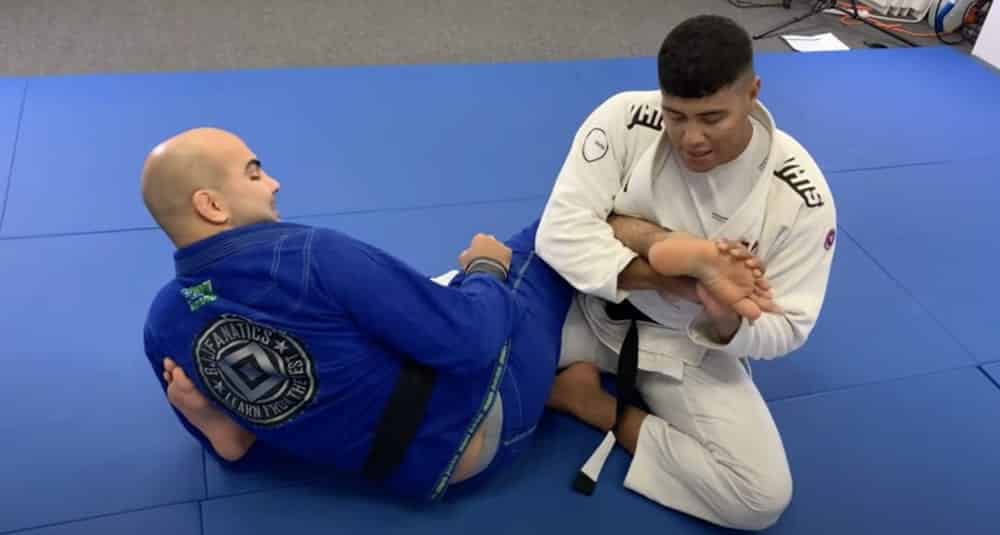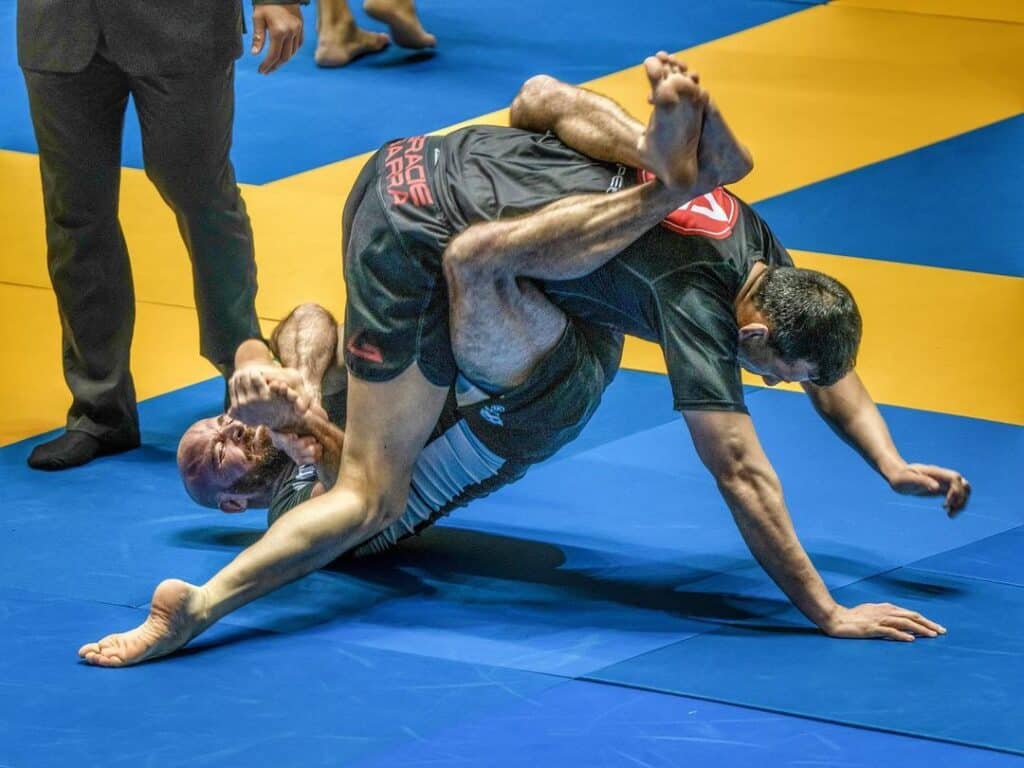Toe Hold – BJJ Submission Explained

Grapplers talk about the power of the heel hook a lot, but there’s another leg lock that’s also pretty nasty. It’s tight, powerful, IBJJF legal, and can wreck someone’s ankle. The toe hold.
A toe hold is a simple and effective leg lock that is frequently used in competitions. Like the heel hook, The toe hold doesn’t take much pressure to make your open quickly tap out.
Here is just about everything you need to know about the toe hold submission. Everything from when it was invented, how it works, and various entries into the submission.

Who invented the toe hold?
The toe hold is another one of these submissions that has been around since the beginning of grappling. No one person can be credited with coming up with the submission.
During the beginning of Jiu Jitsu, foot locks were really frowned upon, but were taught in different curriculums. In Brazil, the toe hold was referred to as the “americana no pe” or “pe de vaca.”
Judo referred to the move as the “ashi dori garami.” Although within Sambo and catch wrestling is really where the move was innovated. BJJ avoided leg attacks, while Sambo and later catch wrestling embraced them.
The submission was rarely used up until the late 90s and early 2000s when No-Gi submission grappling started growing. One of the early innovators of toe hold and other leg locks was American grappler Dean Lister.
Dean Lister was a leg lock innovator that won multiple ADCC championships and holds the record for most wins by leglock. He also inspired John Danaher to create his patented leg lock system.
The toe hold is highly effective and grapplers are still coming up with entries to the submission today.
How does the toe hold work?
The toe hold works similar to how a kimura works on an arm. You grab the top of your opponent’s foot with one hand and grab your wrist with your other hand.
This two on 1 grab is quite powerful and you can create a lot of pressure with very little movement. Just like a lever, you turn your opponent’s foot in a circular motion to the inside of their leg. Putting incredible pressure on your opponent’s ankle.
Many grappler’s that have refused to tap have had their ankles severely dislocated or broken.
How to do a toe hold
This section will be about the mechanic of getting and finishing a toe hold. We’ll detail some of the entries in the other sections.
Let’s say you’ve completed your entry and you’re ready to put on the toe hold. What do you do?
First thing is you need to establish control of your opponent’s leg before getting your toe hold. No leg lock works without proper control of your opponent’s leg.
You have to control your opponent’s leg by locking your leg above their knee. This keeps their leg locked in place and enables you to lock in your submission without them immediately escaping.
Next step is how you hold your opponent’s foot. You need to grab the top of their foot and line up your pinky finger with their pinky toe. Your other hand loops under their foot and you grab your wrist just like doing a kimura.
Once you secure your grip you need to stay tight on your opponent’s leg and keep their foot to your chest. Any free space can allow your opponent to defend and escape.
Now onto finishing your toe hold. Turn their foot inward and aim to turn it towards the same side arm. Be sure to turn their foot using your entire body in order to get the maximum pressure possible.
Toe hold De La Riva defense
A great way to defend your opponent’s De La Riva guard is to grab a toe hold. Your opponent is so focused on controlling your leg that they sometimes forget that their free leg is vulnerable.
To make this technique work, you cannot let your opponent sit-up. If they sit-up in De La Riva, the opening for the toe hold is gone.
Walk right into your opponent’s De La Riva and play around acting like you’re going to try and pass. Then in one motion, you’re going to go grab your toe hold and do a front roll.
When you complete the front roll, lock your legs around theirs and finish your toe hold. It comes on quickly and is very hard to defend.
Toe hold from top half guard
If you’re in your opponent’s half guard and having a hard time passing, you can go for a toe hold. A lot of times your opponent will be so occupied stopping you from passing, they forget about their feet.
From the knee shield, your opponent is keeping you away from them with their knee. Acting like you’re giving them pressure by going into their knee shield.
Then you’re going to turn your hip towards their foot. From there, you quickly grab your toe hold grip as you front roll over your opponent’s legs. Aim your roll towards your opponent’s feet to give yourself more space to crank their foot.
Once you complete the roll, you have your opponent’s legs trapped and you’re free to finish the sub. Crunch your body on their foot as you turn their foot to their back.
Toe hold from single leg x guard
Single leg x guard offers a few leg lock opportunities and the toe hold is one of them. Start in De La Riva guard and transition to single leg x. Do this by removing your DLR hook and rotate your leg in and over your opponent’s leg.
Normally people base out to the side to defend this guard and it opens them up for being leg locked. Grab your own knee and pull it into your opponent’s leg.
This motion forces your opponent to turn inward and give you a better opening to attack their leg. It also brings your opponent’s foot right in front of you to attack.
Reckless toehold
This probably isn’t the best set up, but if you just want to try and dive on a foot you can. It starts with you sitting and your opponent standing over you looking to pass.
Keep your feet on the inside of your opponent and give yourself some distance. Then when you’re ready, dive on their foot and lock in your toe hold grip.
Next after grabbing a hold of the toe hold, you’re going to do a back roll. When you complete your backroll, throw your legs around your opponent’s body and finish the sub.
Toe hold omoplata counter
One of the defenses for a omo plata that’s effective is doing a one handed toe hold to counter the submission.
Once your opponent locks on their omoplata, you have to go through your normal defense. Step your outside foot up and posture up. Be sure to keep your head up high when you posture.
Next look for the opponent’s top leg and grab their foot by their toes. Then pull their foot up and bring it over your head with their ankle on top of your neck.
Since you only have one arm, you use your head and neck to make the leverage for the pressure. Don’t bring your head to their other knee or you won’t generate enough pressure to finish.
Posture up and bend their foot down to set in the pressure.
Tips
The toe hold is a great technique, but easily defendable if you forget important steps. Here are some tips for when you go for a toe hold.
- Pinky to Pinky Toe: When you grab a hold of the foot, make sure your pinky is next to your opponent’s pinky toe. You must have this first grip in order to do a traditional toe hold.
- Kimura Grip: The first type of toe hold grip to learn is where you grab your own wrist just like a kimura. It’s powerful and provides great control.
- Leg Control: Leg control is important, so remember to control your opponent’s leg above their knee, so they can’t escape. This rule also goes for all leg lock submissions.
- Foot To Chest: Again just like a kimura, you must keep your opponent’s foot glued to your chest. Any open space takes away pressure and gives your opponent a chance to escape.
- Turn Inward: To make a toe hold work, you must turn your opponent’s foot inward towards their back.
- Use Your Body: When you turn, use your whole body to exert the maximum amount of force.
- Stay Tight: You must stay tight on your opponent in order to increase your chance of finishing the hold. This will also decrease the chance of them escaping.






